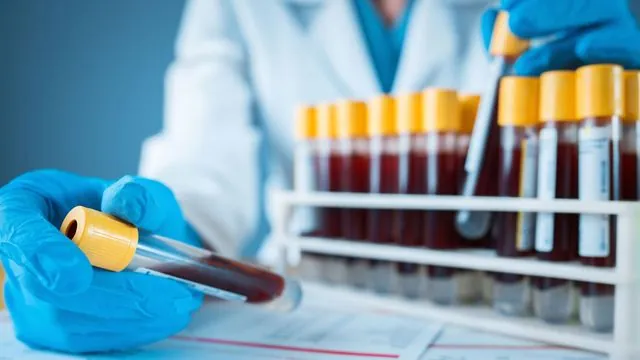
Revolutionary Liquid Biopsy Technique Paves the Way for Early Parkinson's Disease Diagnosis
2024-11-01
Author: Li
Introduction
Recent advancements in medical research have illuminated a groundbreaking approach for detecting Parkinson's Disease (PD) and other neurological disorders at their earliest stages, well before traditional clinical symptoms manifest. Currently, the majority of brain disorders, such as Alzheimer's Disease (AD) and PD, progress unnoticed until significant damage has occurred, rendering early intervention nearly impossible. This situation has sparked an urgent demand for innovative diagnostic methods.
Traditional Methods and Limitations
Traditionally, identifying specific brain lesions linked to PD requires invasive brain biopsies, typically performed post-mortem. However, a new frontrunner in non-invasive diagnostics, known as 'liquid biopsy,' is changing the landscape of early disease detection. This method allows researchers to extract blood or other bodily fluids with ease, searching for molecular signatures linked to brain tissue.
The Role of Extracellular Vesicles
One exciting development lies in extracellular vesicles (EVs)—tiny membrane-bound structures released by cells, including those in the brain. These vesicles carry a plethora of molecules that reflect the health of their parent cells, making them ideal candidates for early biomarkers of degenerative diseases like PD. Nonetheless, scientists have struggled with accurately determining whether specific biomolecules found in these EVs are indeed encapsulated within them or merely attached to their surface, leading to uncertainties in their diagnostic accuracy.
Breakthrough in Research
A collaborative research team, spearheaded by David Walt, Ph.D., of Harvard University's Wyss Institute and Brigham and Women's Hospital, has made significant strides to overcome this hurdle. By enhancing existing protocols to enzymatically remove surface-bound proteins from isolated EVs, the researchers successfully isolated biomolecules securely housed within the vesicles. This breakthrough enables precise measurement of the PD biomarker α-synuclein in blood samples for the first time, providing a clearer picture of its presence in the context of overall plasma levels.
New Detection Techniques
Walt’s team utilized a newly devised ultra-sensitive detection assay capable of identifying phosphorylated variants of α-synuclein, which are known to accumulate during the progression of PD and related disorders like Lewy Body Dementia. In analyzing patient samples, researchers detected a notable increase of the pathological phosphorylated α-synuclein protein within EVs compared to total plasma levels. These findings, published in the prestigious journal *Proceedings of the National Academy of Sciences* (PNAS), highlight the potential of EVs as valuable sources of clinical biomarkers.
Collaborative Support and Methodologies
The research received philanthropic support from notable organizations, including the Chan Zuckerberg Initiative and the Michael J. Fox Foundation. With their enhanced methodologies, the Walt group has developed a framework for quantifying EVs that incorporates advanced size exclusion chromatography (SEC) alongside sensitive Simoa assays. This allowed for a clear differentiation between EVs originating from brain tissue versus those from blood cells, resolving prior uncertainties in concentration estimates.
Understanding β-synuclein in Blood Plasma
Further investigations revealed that less than 5% of total α-synuclein in blood plasma is housed within EVs, a crucial detail as it raises the complexity of distinguishing signals from neuronal EVs amid others circulating in the bloodstream. The team's innovative assays that detect both unmodified and phosphorylated α-synuclein could hold the key to differentiating patients with PD from healthy individuals, moving us closer to a minimally invasive, highly effective diagnostic platform.
Conclusion and Future Implications
As Donald Ingber, M.D., Ph.D., Founding Director of the Wyss Institute, aptly summarized: 'This technological feat may soon allow us to explore the molecular environment of a patient's brain without the invasive procedures historically required.' The implications of these findings are immense, potentially revolutionizing how we approach the diagnosis and treatment of Parkinson's Disease and other neurodegenerative conditions. Early detection could not only provide clearer insights into disease mechanisms but also open doors to timely interventions that might alter the course of these debilitating illnesses. The race is on, and the future of non-invasive diagnostics is looking bright!

 Brasil (PT)
Brasil (PT)
 Canada (EN)
Canada (EN)
 Chile (ES)
Chile (ES)
 España (ES)
España (ES)
 France (FR)
France (FR)
 Hong Kong (EN)
Hong Kong (EN)
 Italia (IT)
Italia (IT)
 日本 (JA)
日本 (JA)
 Magyarország (HU)
Magyarország (HU)
 Norge (NO)
Norge (NO)
 Polska (PL)
Polska (PL)
 Schweiz (DE)
Schweiz (DE)
 Singapore (EN)
Singapore (EN)
 Sverige (SV)
Sverige (SV)
 Suomi (FI)
Suomi (FI)
 Türkiye (TR)
Türkiye (TR)